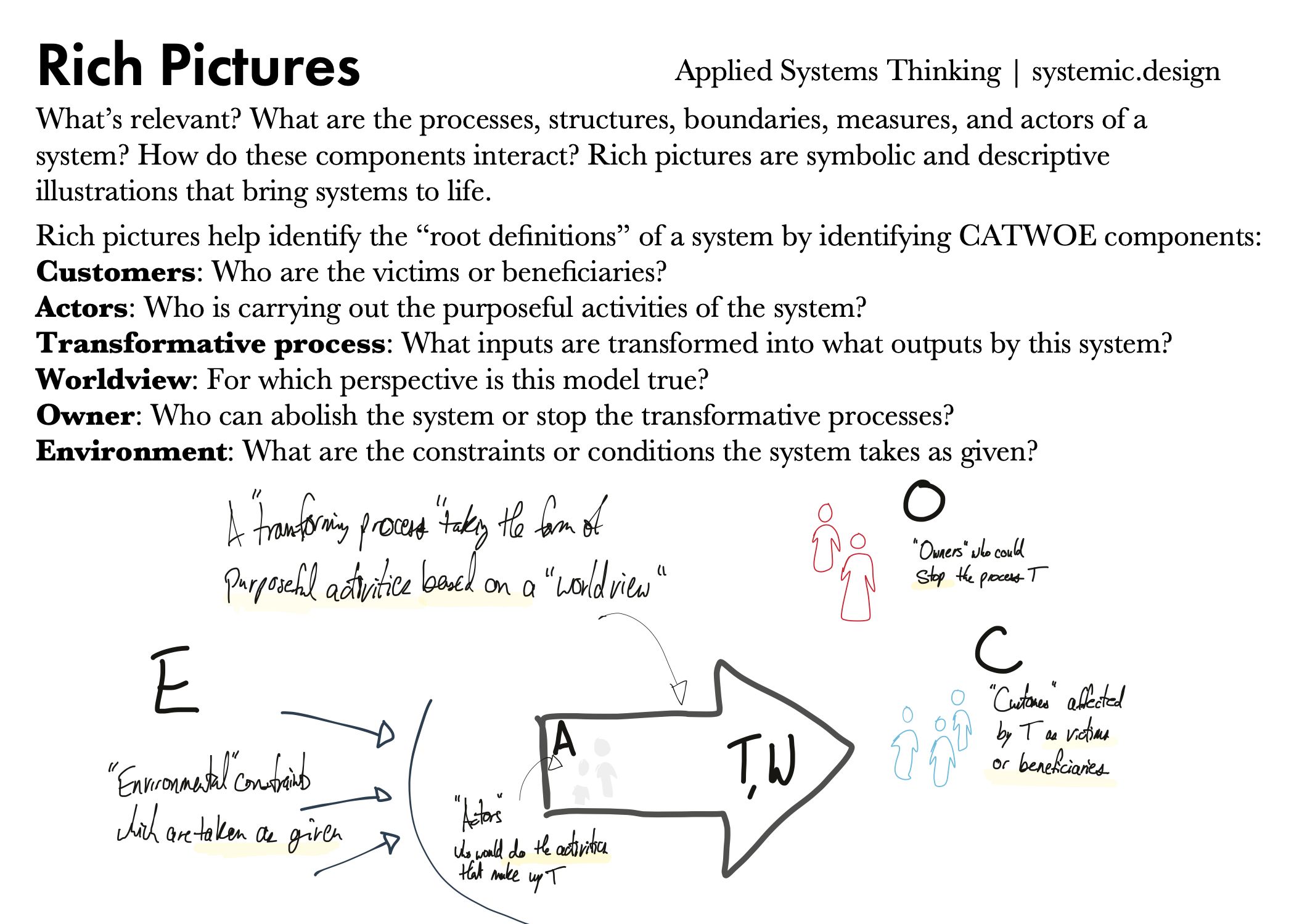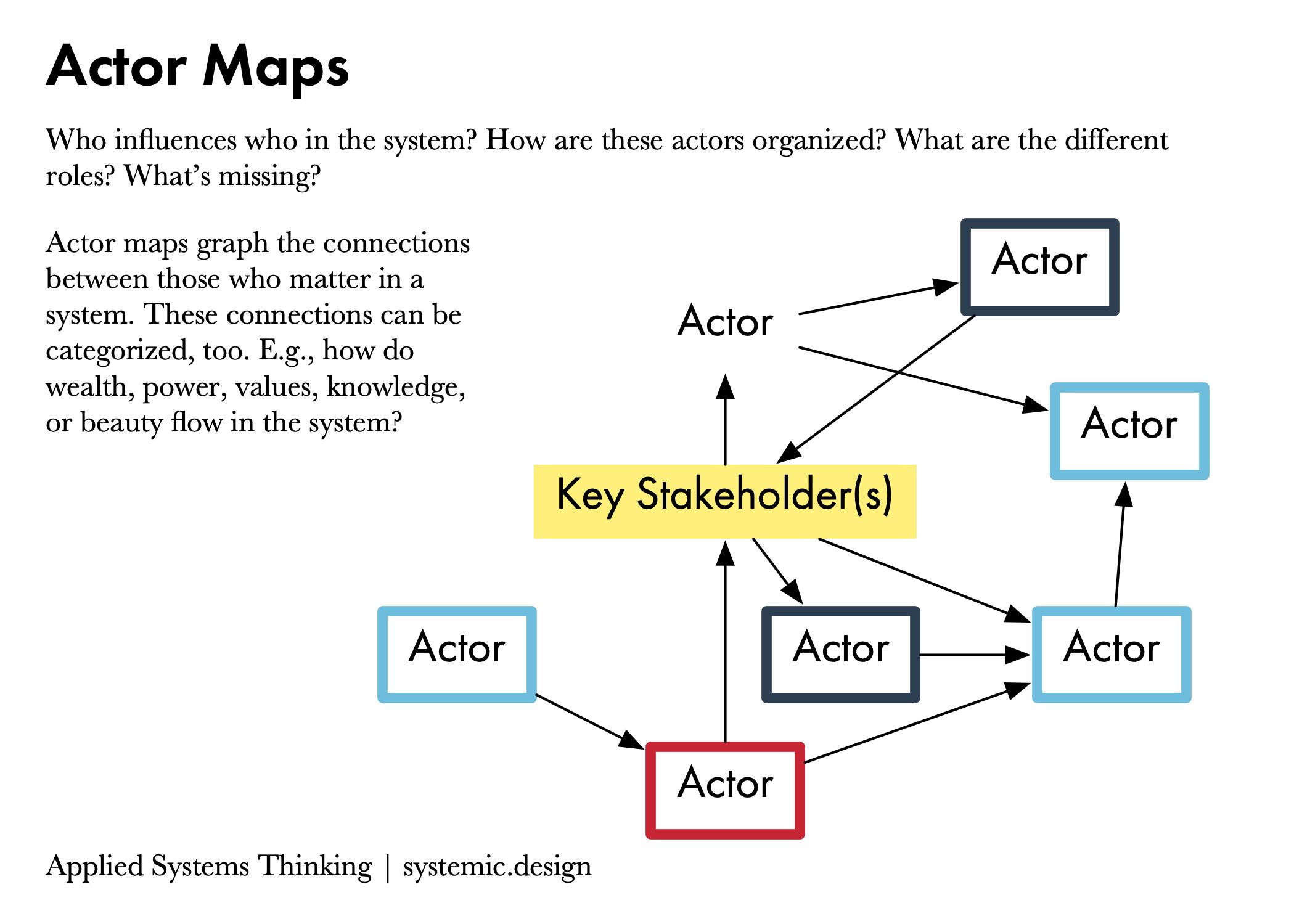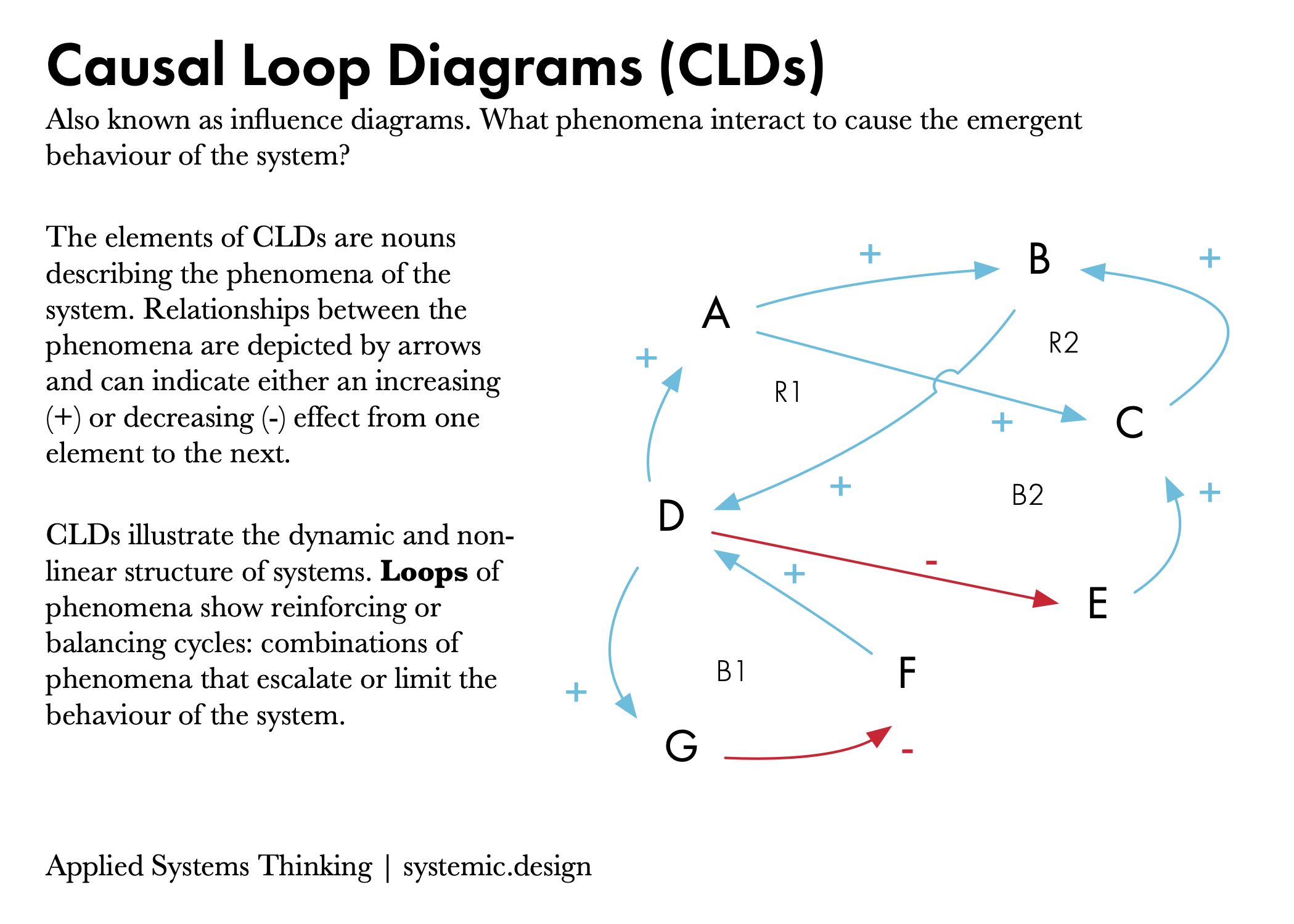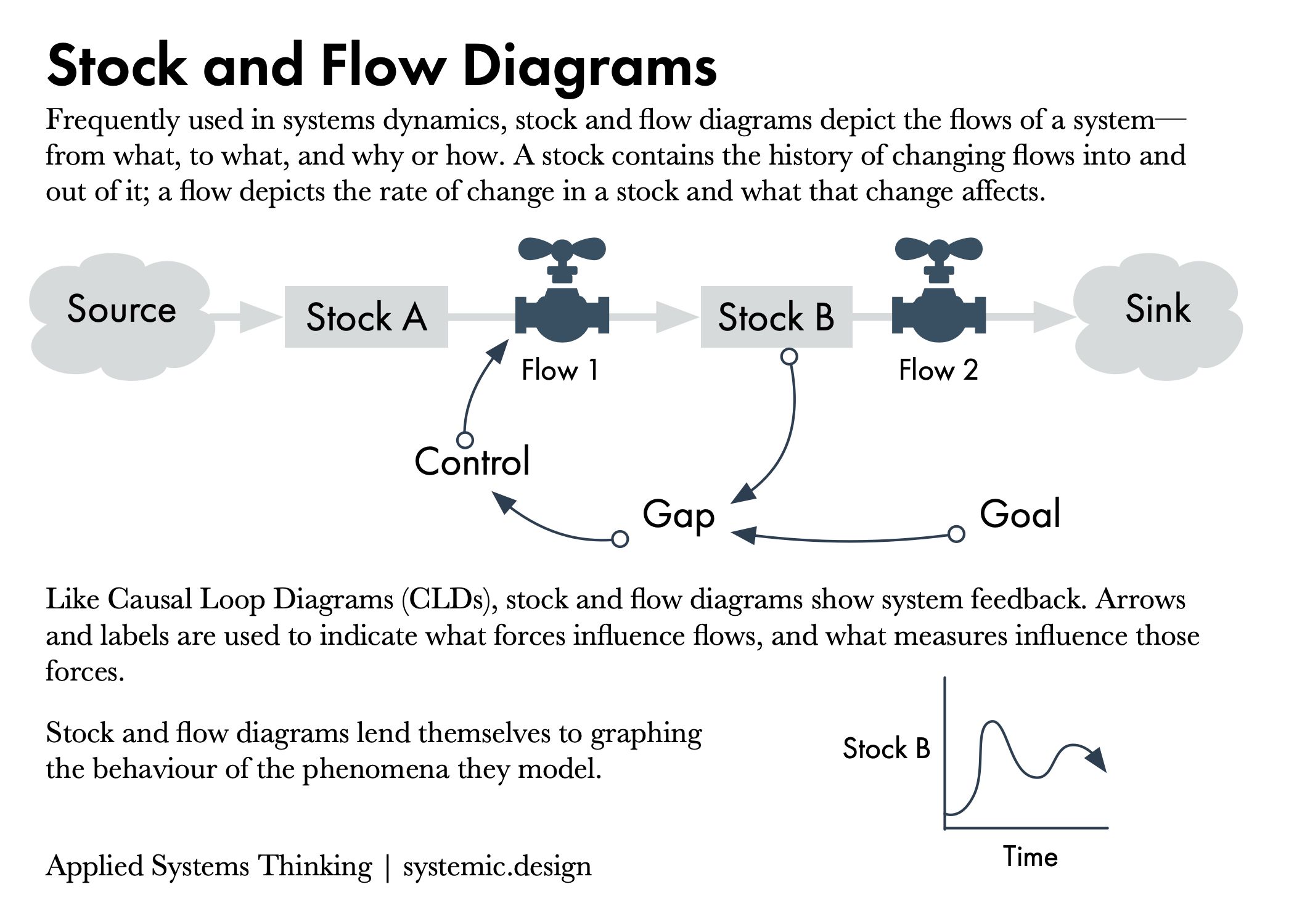Applied Systems Thinking
Based on the Applied Systems Thinking workshop, I’ve collected a variety of resources to help you map complex problems below. The buttons link directly to files to save you some trouble. Be mindful that most of these files are published documents or books, so if you really like them, you should buy a copy and support the authors!
If you have questions or if you’re looking for more resources, never hesitate to reach out to me via ryan@fulcra.design.
Introduction
What are systems? Interconnected sets of elements whose interactions lead to emergent, “purposeful” behaviour. (A system’s purpose is not necessarily what someone intends of it, though, nor can it be derived from rhetoric about the system. A system’s purpose can only be defined by examining its actual behaviour.)
Systems—and the actors within them—do exactly what they are “designed” to do. That is, systems act perfectly in tune with the structures and incentives that they have. Only by understanding these complex structures and incentives can we begin to make real progress on the challenges we’re addressing.
Key Things To Remember
- The most important thing about mapping is not the map itself. It is the conversations that the map (and the mapping process!) can spark.
- Stay focused on answering complex questions. Mapping is not an end in itself. You are “finished” mapping when you’ve answered your focusing questions (more below).
Case Studies
- Remember the story of the development worker trying to support water access in rural Malawi. (37.4 kb) By identifying someone else who was working on a similar problem (community health workers), the development worker was able to gain substantial leverage over their problem with minimal effort. Systems work helps is to identify leverage points.
- Remember the story of The After Prison Initiative (TAPI). (37.4 kb) By helping changemakers working on the same issue see the whole system, each was able to recognize the problems with the system that they were responsible for. Systems help us recognize that every participant in a system has responsibility for the whole system, not just their part.
- Remember the story of the spruce budworm. (37.4 kb) The Atlantic Canadian lumber industry made itself addicted to insecticide by beginning and sustaining insecticide sprays before they understood the long-term forest ecosystem. Systemic innovation is often counterintuitive; the wrong fix in the wrong place can make matters worse.
- Remember the story of the well-intended conference organizers. (37.4 kb) This story teaches two lessons. First, systemic problems are rarely shifted by simple solutions. If you account for only one part of the problem, your fix may fail. Second, it is difficult to understand a systemic problem without involving all of the key stakeholders, particularly the beneficiaries you aim to serve. Involve them in order to see the whole system.
Developing A Focusing Question
Why Are “How Might We..?” Questions Useful?
- “How” invokes a sense of opportunity. Therefore, “How might we..?” questions are appreciative.
- “Might” invokes a sense of pluralism. Therefore, “How might we..?” questions are open-ended: there is more than one possible solution.
- “We” invokes togetherness. Therefore, “How might we..?” questions are pursued collaboratively, particularly by asking and answering questions with stakeholders.
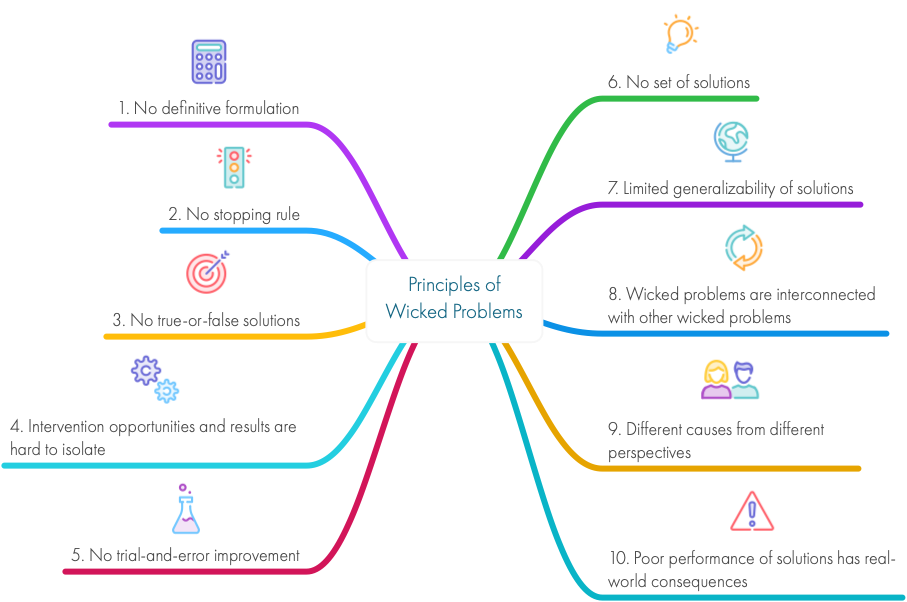
However, “How might we..?” questions aim to provide solutions. Before we can “solve” systemic issues, however, we must understand them. And unfortunately for us, these are usually wicked problems.
To understand a problem, we must begin to explore causality. Systemic designers seek to understand complexity by searching for the patterns that cause our problems—and finding the underlying structure of those patterns that enable their persistence.
To that end, David Stroh suggests developing a “focusing question” in systems work. The purpose of systems mapping, he says, is not to map a system; it is to answer the focusing question.
A focusing question has the form “Why does this problem persist?” or “Why, despite our best efforts, intentions, and resources, have we been unable to achieve a certain goal or solve a particular problem?”
READ MORE ABOUT FOCUSING QUESTIONS (PAGE 92; 5.9 MB)
FOUR TYPES OF SYSTEMS MAPPING
Rich Pictures
LEARN MORE ABOUT SOFT SYSTEMS METHODOLOGY & RICH PICTURES (400 KB)
Rich pictures come from Checkland’s Soft Systems Methodology (SSM). Akin to a sketchy infographic, these maps are illustrated and make heavy use of labels and symbols to help the mapper or the reader understand a messy situation.
Actor Maps
LEARN MORE ABOUT ACTOR MAPPING (1 MB)
Actor maps graph the relationships in a social system. Who (or what organizations) influence who? Who funds who? How is the vision of the system determined? By identifying different stakeholders, including who are the most important beneficiaries and victims of a system, systemic designers might catch gaps, missed connections, or other issues.
Causal Loop Diagrams
LEARN MORE ABOUT CAUSAL LOOP DIAGRAMS
Also known as influence diagrams and effect maps, Causal Loop Diagrams graph the phenomena of a system. What are we trying to stop from happening (or what do we want to happen more often)? What encourages or limits those phenomena? Then, what encourages or limits _those_causes or limits? By drawing causal connections between the phenomena of the system, we can recognize the complex interactions that lead to the (frequently counterintuitive) emergent patterns of behaviour normally invisible.
Stock And Flow Diagrams
LEARN MORE ABOUT STOCK AND FLOW DIAGRAMS (CHAPTER 6; P. 192; 1.2 MB)
How much of what quantities flow at what rates? Stock and flow diagrams make explicit the system’s stores (e.g., the heat in a cup of coffee) and its rates of change (e.g., how quickly heat escapes from the cup). These diagrams also recognize what controls these rates of change.
Applied Systems Thinking
Dimensions Of A System:
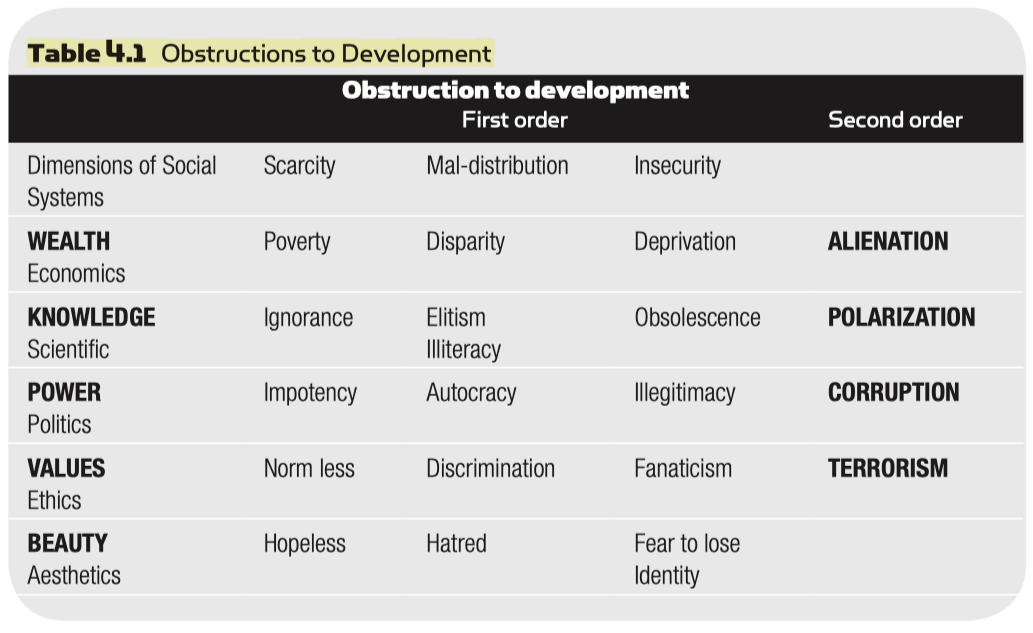
Add detail to your systems maps by exploring the different dimensions along which influence might flow: wealth, power, values, knowledge, or beauty. Different types of obstructions—poverty, maldistribution, and insecurity—can cause different types of problems in each of these dimensions.
READ MORE ABOUT SYSTEMS DIMENSIONS (P. 78; 4.8 MB)
Leverage Points:
Leverage points are places within a system with which a little effort yields great reward. Likewise, bottlenecks are places within a system which resistance could cause significant problems.
Leverage Points:
Leverage points are places within a system with which a little effort yields great reward. Likewise, bottlenecks are places within a system which resistance could cause significant problems.
READ MORE ABOUT LEVERAGE POINTS (225 KB)
Systems Archetypes:
Systems archetypes are common patterns identified in causal loop diagrams or stock-and-flow diagrams. Archetypes exhibit similar behaviours and can be resolved by similar solutions.
READ MORE ABOUT SYSTEMS ARCHETYPES (1.2 MB)
The Systems “Business Idea”:
Do you need a particular actor or phenomena to receive resources/power/etc.? Where would that resource come from? What influences how much of the resource gets distributed? How can you increase those influencing forces? The business idea uses a causal loop diagram to map the systemic structure of an organization’s strategic sustainability. It makes explicit the phenomena that generate resources for the system to reinvest—and the strategic competencies that the organization can use to enhance those phenomena.
READ MORE ABOUT SYSTEMIC BUSINESS IDEAS (P. 11-19; 925 KB)
Systemic Theories Of Change:
What is the change strategy you’re adopting? Similar to the business idea, a systemic theory of change plots a theory of change model in systemic form, identifying the goal phenomena to enhance (or limit), the key activities that can support that enhancement (or limitation), and the inputs required to sustain and scale those activities.
READ MORE ABOUT THEORIES OF CHANGE (396 KB)
Systems Stories:
Never explain a systems map in a pitch or to a general audience. Instead, follow the iceberg model to distill a systems story.
- Describe what happened (an example of the event or phenomena the systemic designer seeks to address);
- Describe what has been happening (the pattern of events that lead to the problem or issue); and
- Describe why (the underlying causal structure that enforces the persistence of these problematic patterns).
READ MORE ABOUT SYSTEMS STORIES (P. 38; 5.9MB)
Technology For Systems Mapping
Mural
Mural.co is a collaborative tool for design sprints. As such, it provides features for collaborative whiteboarding and sticky noting, voting via dotmocracy, and a variety of other neat and helpful tools. It is very free-form (and as such has no features specifically made for systemic design) but that open-endedness may be useful.
Loopy
Nicky Case’s Loopy is a simple tool that allows you to simulate systemic behaviours. It is very unsophisticated (e.g., it is challenging to provide precise system settings) but it is extremely gestural and is therefore fun to use to illustrate and explore ideas.
Plectica
Plectica is a “visual mapping software”. It allows you to nest and draw connections between cards representing anything. The goal of the app is to provide a simple interface for complex ideas.
Kumu
Kumu is a web app built specifically for systems mapping. It features extensive features and documentation and a lively support community full of fellow systems mappers who like to help one another. The developers/founders are active participants in that community and regularly provide customer support, too. Develop actor maps, systems maps, and all kinds of other interesting interactive visuals with Kumu.
ADDITIONAL RESOURCES
I’ve collected and described resources on related topics at https://systemic.design/resources. In particular, you may want to check out the items on organizational change (e.g., the “Notes on Leadership and Language in Regenerating Organizations” paper and the article on organizational learning).


